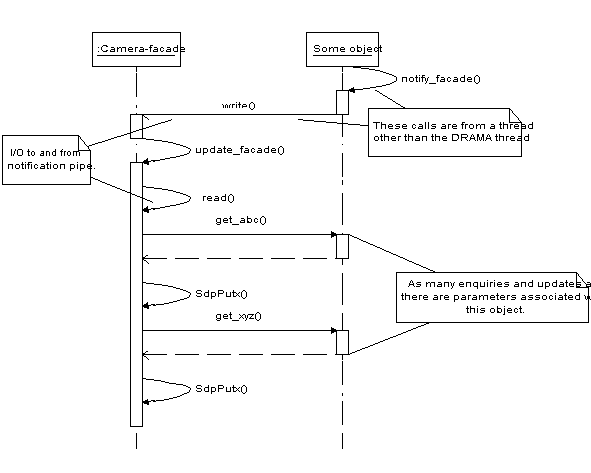 4.2
Implementation of parameters
4.2
Implementation of parameters
This page is part of the ING document INS-DAS-31
Design
notes for UltraDAS
Basic parameter storage
DRAMA parameters in udas_camera are all created and set by the Camera-facade.
They are stored and exported to the DRAMA message-net by the SDP parameter-system
that is standard for DITS. The parameters are all scalars (where a string
is considered to be a scalar) except for two parameters RUN_0 and RUN_1
which are structured. Monitoring of parameters is enabled.
Parameter table
The parameter details - name, type, initial value - are set in the table
param_details,
of type SdpParDefType, which is a private class variable in Camera-facade.
This handling of parameters is a DRAMA standard.
Parameter updates
Most parameters change in response to telemetry updates from objects outside
the Camera-facade. These objects signal to the Facade by calling notify_facade,
saying that they have new telemetry. Notify_facade writes notification
tokens, which are pairs of integers, to a pipe that is a private attribute
of the Camera-facade. The facade receives the notifications asychronously
by reading the pipe while waiting for DRAMA messages.
The trick of reading the notification pipe while waiting for DRAMA messages
is done by declaring the pipe as one of DRAMA's "alternative input" sources,
then using DitsAltInLoop as the message-reception loop in place
of DitsMainLoop. In this usage, the programme blocks in the DRAMA
library-call until either a DRAMA message queue or the pipe is readable;
the effect is like that of the select system-call. When the pipe
becomes readable, DRAMA runs the update_facade callback.
Figure 4.2.1 illustrates the notification mechanism.

Figure 4.2.1: updating parameters.
Update_facade determines which object has signalled from the
notifcation token. The first number in the token is a code for the
type of object, and the second is an instance number identifying a member
of the class of objects. The mechanism only works for objects using the
planned-family pattern, whereby the Camera-facade can retrieve a pointer
to the object from the instance number.
Structured parameters
The parameters RUN_0 and RUN_1 are structured. Their SDS structures map
directly to the C structure of type progress_st defined in the Camera-facade.
The SDS structures for initializing the parameters are generated by code
made with the SDS compiler (in the SDS package of DRAMA), but this code
is now included in the Camera-facade class; the SDS compiler is not used
in the udas_camera makefile.
The structured parameters are set by copying an equivalent C structure
into their SDS structures. The C structure is constructed inside the Camera-facade
from scalar itemes of telemetry.
 4.2
Implementation of parameters
4.2
Implementation of parameters 4.2
Implementation of parameters
4.2
Implementation of parameters